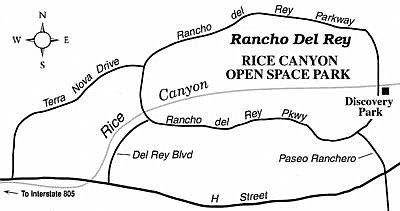 Facebook
Facebook
 X
X
 Instagram
Instagram
 TikTok
TikTok
 Youtube
Youtube
On the scrub-covered slopes overlooking eastern Chula Vista's Rice Canyon, hardy coast chollas raise their asymmetric arms in what seems a gesture of defiance against the surrounding phalanxes of cookie-cutter, pseudo-Spanish-style homes. The yellow-centered, magenta blossoms at their tips are opening now -- though much of the remainder of the vegetation in the canyon is beginning its summer-dormant phase.
Throughout the San Diego region, from Oceanside to Otay Mesa, thin strips of canyon open space like this break the symmetry of the urban and suburban continuum. Sometimes, as in the case of Chula Vista's newer planned communities, shreds of natural landscape survive by design. In many older neighborhoods, the canyons separating the mesas were, and still are, too steep and narrow to have been developed.
What remains of the formerly obscure Rice Canyon (now called Rice Canyon Open Space Preserve) stretches some two miles west from Discovery Park, off East H Street, west of Southwestern College. From a small parking/staging area across from the park, a wide, sandy, mostly flat trail runs for a total of two miles down the canyon to a point on East H Street about one mile east of Interstate 805. At the trailhead itself, and at a mailbox about midway down the canyon, you may find a free, color-photo-illustrated leaflet (produced by Southwestern College) describing the canyon's native vegetation. The largest bushes in sight on the canyon slopes are lemonade berry shrubs, with sticky fruit that Native Americans once used to prepare a beverage similar to lemonade.
As you make your way down the canyon on a typical early summer morning, the marine-layer clouds begin to part and salt-tinged air pushes inland from south San Diego Bay. The shriveling California sagebrush plants coating the canyons exude a spicy fragrance. Bird, cricket, and cicada songs waft on the breeze. White and yellow butterflies flit amid the late blooming weeds and wildflowers.


On the scrub-covered slopes overlooking eastern Chula Vista's Rice Canyon, hardy coast chollas raise their asymmetric arms in what seems a gesture of defiance against the surrounding phalanxes of cookie-cutter, pseudo-Spanish-style homes. The yellow-centered, magenta blossoms at their tips are opening now -- though much of the remainder of the vegetation in the canyon is beginning its summer-dormant phase.
Throughout the San Diego region, from Oceanside to Otay Mesa, thin strips of canyon open space like this break the symmetry of the urban and suburban continuum. Sometimes, as in the case of Chula Vista's newer planned communities, shreds of natural landscape survive by design. In many older neighborhoods, the canyons separating the mesas were, and still are, too steep and narrow to have been developed.
What remains of the formerly obscure Rice Canyon (now called Rice Canyon Open Space Preserve) stretches some two miles west from Discovery Park, off East H Street, west of Southwestern College. From a small parking/staging area across from the park, a wide, sandy, mostly flat trail runs for a total of two miles down the canyon to a point on East H Street about one mile east of Interstate 805. At the trailhead itself, and at a mailbox about midway down the canyon, you may find a free, color-photo-illustrated leaflet (produced by Southwestern College) describing the canyon's native vegetation. The largest bushes in sight on the canyon slopes are lemonade berry shrubs, with sticky fruit that Native Americans once used to prepare a beverage similar to lemonade.
As you make your way down the canyon on a typical early summer morning, the marine-layer clouds begin to part and salt-tinged air pushes inland from south San Diego Bay. The shriveling California sagebrush plants coating the canyons exude a spicy fragrance. Bird, cricket, and cicada songs waft on the breeze. White and yellow butterflies flit amid the late blooming weeds and wildflowers.
